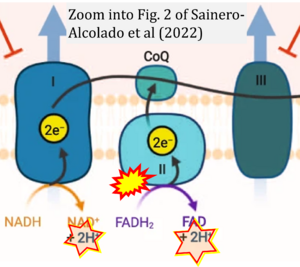Sainero-Alcolado 2022 Cell Death Differ
| Sainero-Alcolado L, Liaño-Pons J, Ruiz-Pérez MV, Arsenian-Henriksson M (2022) Targeting mitochondrial metabolism for precision medicine in cancer. Cell Death Differ 29:1304-17. https://doi.org/10.1038/s41418-022-01022-y |
Sainero-Alcolado L, Liano-Pons J, Ruiz-Perez MV, Arsenian-Henriksson M (2022) Cell Death Differ
Abstract: During decades, the research field of cancer metabolism was based on the Warburg effect, described almost one century ago. Lately, the key role of mitochondria in cancer development has been demonstrated. Many mitochondrial pathways including oxidative phosphorylation, fatty acid, glutamine, and one carbon metabolism are altered in tumors, due to mutations in oncogenes and tumor suppressor genes, as well as in metabolic enzymes. This results in metabolic reprogramming that sustains rapid cell proliferation and can lead to an increase in reactive oxygen species used by cancer cells to maintain pro-tumorigenic signaling pathways while avoiding cellular death. The knowledge acquired on the importance of mitochondrial cancer metabolism is now being translated into clinical practice. Detailed genomic, transcriptomic, and metabolomic analysis of tumors are necessary to develop more precise treatments. The successful use of drugs targeting metabolic mitochondrial enzymes has highlighted the potential for their use in precision medicine and many therapeutic candidates are in clinical trials. However, development of efficient personalized drugs has proved challenging and the combination with other strategies such as chemocytotoxic drugs, immunotherapy, and ketogenic or calorie restriction diets is likely necessary to boost their potential. In this review, we summarize the main mitochondrial features, metabolic pathways, and their alterations in different cancer types. We also present an overview of current inhibitors, highlight enzymes that are attractive targets, and discuss challenges with translation of these approaches into clinical practice. The role of mitochondria in cancer is indisputable and presents several attractive targets for both tailored and personalized cancer therapy.
• Bioblast editor: Gnaiger E
Correction: FADH2 and Complex II
- FADH2 is shown as the substrate feeding electrons into Complex II (CII). This is wrong and requires correction - for details see Gnaiger (2024).
- Gnaiger E (2024) Complex II ambiguities ― FADH2 in the electron transfer system. J Biol Chem 300:105470. https://doi.org/10.1016/j.jbc.2023.105470 - »Bioblast link«
Hydrogen ion ambiguities in the electron transfer system
Communicated by Gnaiger E (2023-10-08) last update 2023-11-10
- Electron (e-) transfer linked to hydrogen ion (hydron; H+) transfer is a fundamental concept in the field of bioenergetics, critical for understanding redox-coupled energy transformations.
- However, the current literature contains inconsistencies regarding H+ formation on the negative side of bioenergetic membranes, such as the matrix side of the mitochondrial inner membrane, when NADH is oxidized during oxidative phosphorylation (OXPHOS). Ambiguities arise when examining the oxidation of NADH by respiratory Complex I or succinate by Complex II.
- Oxidation of NADH or succinate involves a two-electron transfer of 2{H++e-} to FMN or FAD, respectively. Figures indicating a single electron e- transferred from NADH or succinate lack accuracy.
- The oxidized NAD+ is distinguished from NAD indicating nicotinamide adenine dinucleotide independent of oxidation state.
- NADH + H+ → NAD+ +2{H++e-} is the oxidation half-reaction in this H+-linked electron transfer represented as 2{H++e-} (Gnaiger 2023). Putative H+ formation shown as NADH → NAD+ + H+ conflicts with chemiosmotic coupling stoichiometries between H+ translocation across the coupling membrane and electron transfer to oxygen. Ensuring clarity in this complex field is imperative to tackle the apparent ambiguity crisis and prevent confusion, particularly in light of the increasing number of interdisciplinary publications on bioenergetics concerning diagnostic and clinical applications of OXPHOS analysis.
Cited
- Silva et al (2021) Off-target effect of etomoxir on mitochondrial Complex I. MitoFit Preprints 2021. (in preparation)
Labels:
MitoFit 2021 Etomoxir




